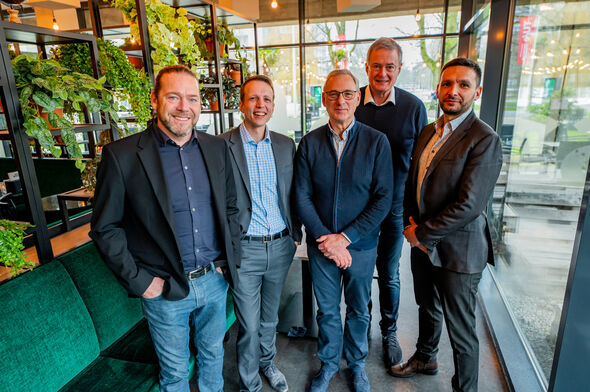Will Eindhoven get a Smart Supercomputing Center?
Joris Poort, CEO of supercomputing platform Rescale, visited Tu/e’s HPC Lab on Monday morning. The lab for supercomputing (aka High Performance Computing) enables scientists and students to use supercomputers to solve scientific problems. HPC Lead Richard Zoontjens and Poort hope to increase their future collaboration for the benefit of the university and the Brainport region.
Poort was born in Nijmegen and made it big in Silicon Valley, backed by huge sponsors such as Sam Altman (OpenAI, ChatGPT), Jeff Bezos (CEO of Amazon), Richard Branson (CEO of Virgin), and Microsoft. His company Rescale is now the market leader for supercomputing in the cloud. The HPC Lab successfully uses Rescale cloud services for researchers, but also for student teams such as Solarteam, URE and FruitPunch AI. Non-affiliated TU/e students are also welcome, of course.
“This Eindhoven lab is world class,” Poort says. “We are currently facing societal challenges such as climate change, the energy transition, vaccine development, and drug research. To meet these challenges, we need computer models (simulations). These allow us to calculate and digitally test theories before applying them to the real world (e.g. in the form of ‘digital twins’). Giving scientists more and easier access to supercomputing services means they can solve a greater number of global problems.”
Poort is an authority on the matter, as he worked at Boeing for years and used supercomputers to develop the Boeing 787. But first he had to learn a lot about computer science, even though aerospace engineering is his forte. “The sole reason I was able to solve the issues at Boeing was that I had mastered the relevant computer science. It’s a shame if you need years to acquire the necessary knowledge of supercomputing before you can work with it. Rescale flattens the learning curve and makes the interface more accessible. The lab assistants at the HPC lab can also assist you if necessary. Making supercomputing accessible is very important to me, because people often think that all scientists and students can use supercomputers. But that’s not the case, not yet anyway. Also, a lot of organizations think that it’s crucial to build their own physical supercomputer, that that’s the only way. But it’s not. We set up Rescale in such a way that it gives its users cloud access to multiple supercomputers around the world.”
Richard Zoontjens had acquired experience creating a High Performance Computing environment at ASML before he started the HPC Lab. He knows Joris Poort from back in the day. Zoontjens and his team’s main focus is on human support required for the technology offered to scientists and students by the HPC Lab. “I see our supercomputing solutions as a Swiss army knife, with our lab assistants knowing exactly which of its many tools you need to get the optimal result.”
National calculation model
Zoontjens gives us an example to illustrate the practical applications of supercomputing. “The HPC Lab assisted TU/e professor Lisanne Havinga (department of the Built Environment) in using the national supercomputer for her research on the energy transition in homes. We enhanced her scope tenfold, resulting in a calculation model that tells us exactly how to best make a home sustainable. The government adopted her calculation model and now it’s used for every home in the Netherlands.”
Zoontjens has another example, in this case to do with students. “FruitPunch, which developed from a student team into a startup, uses unmanned aircraft and AI models to look for poachers. This is possible because they have started using Rescale in the cloud. The possibilities are endless in comparison to those offered by a regular student laptop or big computer underneath a table somewhere.”
The future
Poort and Zoontjens hope to increase their collaboration with Brainport. “Brainport is growing rapidly and TU/e is also committed to substantial growth (through the scale jump),” says Zoontjens. “These kinds of tools are relevant for this entire environment. Researchers can’t do without high performing computer facilities and services,” he asserts. And about his dreams for the future: “Within a few years this may turn into a project attracting a great deal of attention, such as the wind tunnel a while back. We could call it the Eindhoven ‘Smart’ Supercomputing Center, focusing on supercomputing support for research questions and collaboration projects between Dutch universities and with Brainport-based companies, government organizations and education institutes.”
Poort definitely sees an added value in increasing access to supercomputing at and around a university: “Tomorrow’s major problems are solved by today’s students, so it’s key they already learn to involve supercomputing in their research. And if more universities give their students access, it gets easier for those universities to collaborate with one another. The same goes for public-private partnerships, of course.”
Give it a try?
Rescale is not the only option the HPC lab offers to scientists and students when it comes to calculations. More applications are available and the lab assistants can help you figure out which one fits your research best. Options include local solutions as well as the national supercomputing facilities offered by SURF.
Interested to learn how you could use supercomputing? The HPC-lab (note: this is an intranet link) organizes a biannual information day where you can learn about the different possibilities. The next one is scheduled for March, exact date to be announced.




Discussion